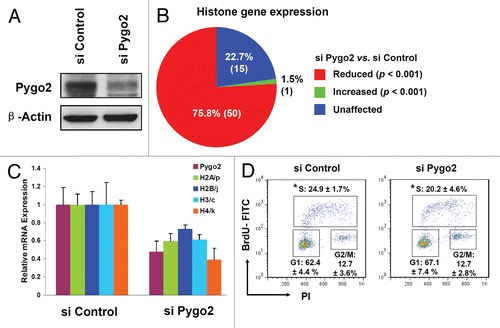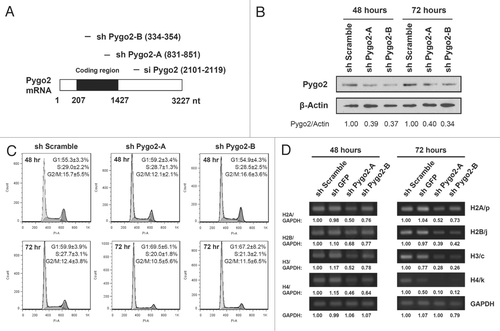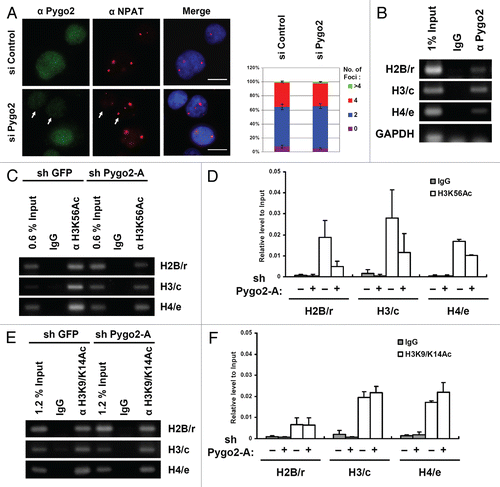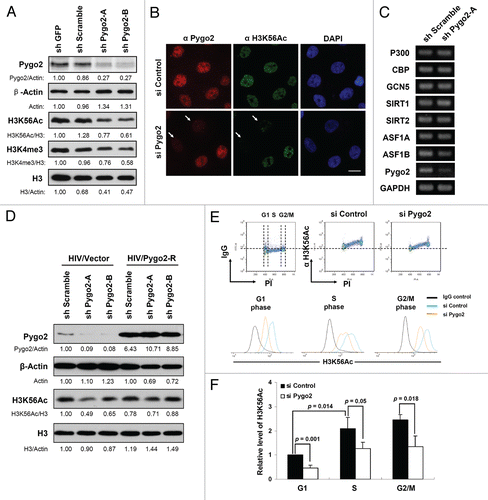Figures & data
Figure 1 Altered histone gene expression in Pygo2-knockdown MCF10A cells. (A) Protein gel blot analysis showing effective depletion of Pygo2 protein at 24 h after siRNA treatment. (B) Pie diagram showing microarray data on histone gene expression upon Pygo2 knockdown. (C) RT-qPCR analysis of select histone genes. Shown are average values from two independent experiments with standard deviations. (D) Flow cytometry analysis of DNA content (propidium iodide, or PI) and DNA synthesis (BrdU) in siRNA-treated cells (24 h after treatment). Shown are profiles from a representative experiment as well as average values from three independent experiments with standard deviations. *p = 0.17 using two-tailed t-tests assuming equal variance.

Figure 2 Histone gene expression change precedes cell cycle arrest in Pygo2-depleted MCF10A cells. (A) Schematic diagram showing the design of siRNA/shRNAs for human Pygo2. (B) Protein gel blot analysis of MCF10A whole-cell lysates showing knockdown of Pygo2 at 48 and 72 h post-infection. Signals are quantified by ImageJ 1.43u and normalized as indicated. (C) Flow cytometry analysis of cell cycle progression of infected cells as in (B). Shown are profiles from a representative experiment as well as average values from three independent experiments with standard deviations. (D) RT-qPCR analysis of select histone genes after knockdown of Pygo2. Similar results are obtained from two independent experiments. Expression levels are quantified and normalized against GAPDH control.

Figure 3 Pygo2 occupancy and H3K56 acetylation at select histone promoters. (A) Immunofluorescence analysis of Pygo2 (green) and NPAT-associated HLBs (red) 24 h after siRNA treatment. White arrows indicate Pygo2-depleted cells. Cell nuclei are stained blue with DAPI. Scale bar: 10 µm. Quantification of HLBs in control (n = 103) and Pygo2-knockdown (n = 91) cells is shown on the right. Error bars indicate standard deviations of two independent experiments. (B) ChIP analysis of Pygo2 occupancy on select histone gene promoters. GAPDH promoter was used as a negative control. (C–F) ChIP analysis of H3K56Ac (C and D) and H3K9/K14Ac (E and F) at select histone promoters after treatment with the indicated shRNAs. (D and F) are quantifications of ChIP experiments in (C and E), respectively. Error bars are standard deviations of two independent experiments.

Figure 4 Reduced global H3K56Ac in Pygo2-knockdown cells. (A) Protein gel blot analysis of cellular H3K56Ac levels in shRNA-treated cells. MCF10A cells were infected with the indicated shRNA-expressing lentivirus for 3 d. Signals are quantified and normalized as indicated. (B) Immunofluorescence analysis of H3K56Ac in siRNA-treated cells (24 h). (C) RT/semi-quantitative PCR analysis of known H3K56Ac-regulating proteins 3 d after shRNA-viral infection. (D) Protein gel blot analysis of H3K56Ac in cells infected with lentiviruses that express the indicated shRNAs plus either lentiviruses that express a RNAi-resistant form of Pygo2 or vector control. Signals are quantified and normalized as indicated. (E) Flow cytometry analysis of H3K56Ac during cell cycle progression. Shown at the top are representative profiles of H3K56Ac/DNA content (PI) from siRNA-treated MCF10A cells (24 h). Bottom, altered H3K56Ac levels at the indicated cell cycle stages. (F) Quantification of results from (E). Error bars are standard deviations of three independent experiments. p-values are calculated using two-tailed t-tests assuming equal variance.
